Today’s Current Affairs: 23rd April 2025 for UPSC IAS exams, State PSC exams, SSC CGL, State SSC, RRB, Railways, Banking Exam & IBPS, etc
Table of Contents
Bullseye Galaxy : Recently Discovered
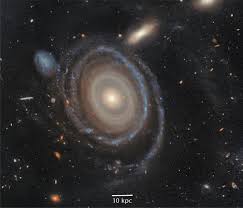
The Bullseye Galaxy (LEDA 1313424) was recently discovered by an international team of researchers using the Hubble Space Telescope and W.M. Keck Observatory.
- The galaxy’s distinct ringed structure is believed to have formed approximately 50 million years ago due to a head-on collision with a blue dwarf galaxy.
- This head-on collision is believed to have caused rippling gas waves, leading to star formation in ring-like patterns.
- This discovery was termed “serendipitous” as ringed galaxies usually have only two or three rings.
- Observed Through Multiple Telescopes:
- The Hubble Space Telescope confirmed eight rings.
- The M. Keck Observatory in Hawaii confirmed a ninth ring, revealing the full structure.
- The Bullseye Galaxy spans 250,000 light-years in diameter — nearly 5 times larger than the Milky Way. Despite a current separation of 130,000 light-years, a thin trail of gas still connects it to the colliding dwarf galaxy.
- The Bullseye may evolve into a Giant Low Surface Brightness (GLSB) Galaxy, a rare, massive galaxy type believed to hold clues about dark matter.
- Giant Low Surface Brightness (GLSB) Galaxy features:
- Composed of diffuse, low-density stellar disks.
- Contain large amounts of neutral hydrogen but exhibit low star formation rates.
- Include examples like Malin 1, which is 5 times wider than the Milky Way.
- GLSB galaxies are believed to be rich in dark matter, and their unusual mass distribution challenges the Standard Model of Cosmology.
- These galaxies display a uniform central mass instead of a dense core, suggesting discrepancies in current models.
Nitrogen:
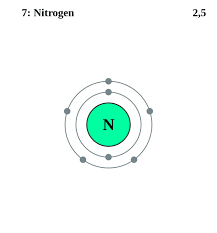
India, the world’s second-largest emitter of N₂O after China, faces climate risks as N₂O has 300 times the global warming potential of CO₂.
- Nitrogen is the most abundant atmospheric gas, constituting ~78% of Earth’s atmosphere.
- Nitrogen is vital for forming DNA, ATP (cellular energy currency), proteins, chlorophyll, and acts as a neurotransmitter via nitric oxide (NO).
- Reactive nitrogen (ammonia, nitrate, nitrous oxide) is now overproduced through chemical fertilisers.
- 80% of applied nitrogen is lost to the environment via leaching and emissions, causing:
- Eutrophication of water bodies → Algal blooms, Dead Zones (e.g., Gulf of Mexico).
- Soil acidification and air pollution from NOx emissions.
- Formation of ground-level ozone and acid rain.
- N₂O (Nitrous oxide) is now the third most potent greenhouse gas after CO₂ and CH₄.
Democratic Republic of the Congo:

Kinshasa is one of 38 flood hotspots in the Congo Basin, due to its twin flood sources and urbanisation.
- The April 2025 flooding in Kinshasa, capital of the Democratic Republic of Congo (DRC), was not solely due to rainfall but largely due to urban mismanagement and infrastructure failure.
- The flooding, triggered by local rains and runoff from the Congo Central Province, overwhelmed urban tributaries like the Ndjili River and Lukaya tributary.
- The disaster resulted in 70 deaths, 150 injuries, and displacement of over 21,000 people. It also affected 73 healthcare facilities and disrupted water and transport services.
- Current instability in eastern DRC due to the M23 armed group, causing mass displacement.
- Democratic Republic of the Congo (DRC) Capital: Kinshasa
- It is 2nd largest country in Africa (after Algeria), and largest in Sub-Saharan Africa
- Borders: Angola, Burundi, CAR, Congo, Rwanda, Sudan, Tanzania, Uganda, Zambia
- Coastline: Small boundary along the Atlantic Ocean
- Congo Basin is home to the world’s largest tropical peatlands
- Rich in cobalt, copper, gold, lithium, iron ore, and coal.
SpaDeX Mission : Completed Second Docking
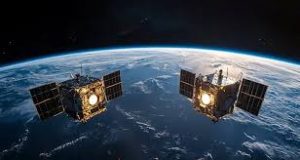
The Indian Space Research Organisation (ISRO) has successfully completed the second docking of its two satellites — SDX01 (Chaser) and SDX02 (Target) — under the SpaDeX (Space Docking Experiment) mission.
- SpaDeX (Space Docking Experiment) is a technology demonstration mission developed by ISRO to validate the capability of docking and undocking two small satellites in low-Earth orbit.
- The mission involved two small satellites, each weighing around 220 kg: SDX01 (Chaser), SDX02 (Target)
- These satellites were launched by PSLV-C60 into a 460 km circular orbit with an inclination of 45 degrees.
- Primary objective: To develop and demonstrate the capability for rendezvous, docking, and undocking of spacecraft in orbit.
- Secondary objectives is To demonstrate the transfer of electric power between docked spacecraft — a crucial component for future in-space operations, To develop and validate composite spacecraft control systems, To test payload operations after undocking — important for deep-space missions.
- With this achievement, India becomes the fourth country after the United States of America, Russia, and China to successfully conduct satellite docking operations.
Article 355 of the Indian Constitution:
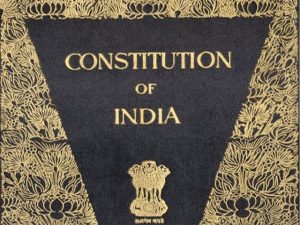
The Supreme Court recently appeared surprised over a petition seeking the invocation of Article 355 in West Bengal, citing violence in Murshidabad district during protests against the Waqf Amendment Act.
- It is a part of emergency provisions contained in Part XVIII of the Constitution of India, from Article 352 to 360.
- It empowers the Centre to take necessary steps to protect a state from any kind of threat, be it internal or external.
- It allows the Centre to take charge of a state’s law and order enforcement without dismissing the government, and is considered a step below the President’s rule, which gives full control to the President.
- The provision is designed to ensure that the government can act swiftly and decisively in the event of any disturbance or threat to the peace and security of the country.
- The exact definition of Article 355 in the Constitution of India is, “It shall be the duty of the Union to protect every State against external aggression and internal disturbance and to ensure that the government of every State is carried on in accordance with the provisions of this Constitution.”
Hindu Kush Himalaya : Lowest Snow

The Hindu Kush Himalaya (HKH) region recorded its lowest snow persistence in 23 years during the 2024–2025 winter, according to a new report published recently.
- The HKH mountains extend around 3,500 km over eight countries — Afghanistan, Bangladesh, Bhutan, China, India, Nepal, Myanmar, and Pakistan.
- It covers an area of approximately 4.2 million sq.km.
- It runs northeast to southwest and divides the valley of the Amu Darya (the ancient Oxus River) to the north from the Indus River valley to the south.
- To the east the Hindu Kush buttresses the Pamir range near the point where the borders of China, Pakistani-administered Kashmir, and Afghanistan meet, after which it runs southwest through Pakistan and into Afghanistan, finally merging into minor ranges in western Afghanistan.
- The range has numerous high snow-capped peaks, with the highest point being Tirich Mir or Terichmir at 7,708 meters (25,289 ft) in Chitral, Pakistan.
- It is considered the Third Pole (after the North and South Poles) and has significant implications for climate.
- The HKH forms the largest area of permanent ice cover outside of the North and South Poles and is home to 4 global biodiversity hotspots.
- The HKH region is the source of ten large Asian river systems: the Amu Darya, Indus, Ganges, Brahmaputra, Irrawaddy, Salween, Mekong, Yangtse, Yellow River, and Tarim.
- The basins of these rivers provide water to 1.9 billion people, a fourth of the world’s population.
- Contains diverse ecosystems: glaciers, alpine meadows, forests, wetlands, and grasslands.
- HKH may be divided into three main sections: the eastern Hindu Kush, the central Hindu Kush, and the western Hindu Kush, also known as the Bābā Mountains.
- The inner valleys of the Hindu Kush see little rain and have desert vegetation.
Gold’s Rising Share in India’s Forex Reserve:

As per the World Gold Council (WGC), India’s gold share in foreign exchange reserves has nearly doubled from 6.7% in 2019 to 12% by February 2025.
- India’s forex reserves rose to USD 677.84 billion in April 2025, led by an increase of USD 892 million in FCA and a USD 638 million rise in gold reserves, while SDRs fell by USD 6 million.
- Forex are reserve assets held by a central bank in foreign currencies. It may include foreign currencies, bonds, treasury bills and other government securities, typically denominated in US dollars.
- They are an important component of the Balance of Payment (BoP)
- The RBI is the custodian of India’s foreign exchange reserves, deriving its authority from the provisions of the RBI Act, 1934.
KVIC’s Record Growth Fuels Rural Empowerment:

The Khadi and Village Industries Commission (KVIC) has recorded an unprecedented turnover of over Rs 1.7 lakh crore for FY 2024-25.
- Over the past 11 years (2013–2025), KVIC production rose by 347% and sales by 447%. Employment grew by 49.23%, providing jobs to 1.94 crore individuals.
- Khadi clothes production increased by 366%, and sales surged by 561%. Khadi artisans’ wages rose by 275% over 11 years, with a 100% increase in the last 3 years.
- Women make up 57.45% of KVIC trainees, and 80% of Khadi artisans are women.
- KVIC is a statutory body established under the KVIC Act, 1956 and functions under the Ministry of Micro, Small & Medium Enterprises.
- It is responsible for the planning, promotion, and development of Khadi and village industries in rural areas.
- KVIC provides raw materials, supports marketing, promotes research and innovation, ensures product authenticity, and offers financial and technical support. State-level Khadi Boards implement KVIC schemes locally.
India-Saudi Arabia Relations:
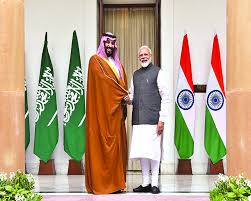
Prime Minister of India visit to Saudi Arabia aims to strengthen the growing India-Saudi Strategic Partnership, with new agreements expected in trade, defence, and investment under the Strategic Partnership Council framework.
- Establishment of Diplomatic Ties: Formal diplomatic relations were established in 1947.
- Delhi Declaration (2006) during King Abdullah’s visit laid the foundation for a strategic partnership.
- Riyadh Declaration (2010) during PM Manmohan Singh’s visit elevated the relationship to a new strategic level.
- PM Modi’s visits in 2016, 2019, and 2025 have expanded the scope to energy, defence, space, and culture.
- Saudi Crown Prince Mohammed bin Salman’s visits to India in 2019 and 2023 further deepened ties.
- Saudi Arabia is India’s 5th largest trading partner with bilateral trade of USD 42.98 billion (FY 2023-24).
- Huge investment potential, including PIF’s USD 10 billion investment in sectors like retail, technology, and agriculture.
- Saudi Arabia remains India’s 3rd largest crude oil supplier, contributing 3% of India’s oil imports in 2023-24.
- Collaboration in renewables through the International Solar Alliance (ISA).
- Increasing defence exchanges, naval exercises like Al Mohed Al Hindi, and joint land forces exercise Ex-Sada Tanseeq-I held in 2024.
- Indian diaspora in Saudi Arabia numbers 7 million, acting as a vital socio-economic bridge.
- Cultural MoUs, yoga cooperation, and growing tourism and sports engagement.
India’s Trade Triumph and Its Environmental Toll:
India’s trade contribution is projected to reach 6% of global trade growth by 2025 (DHL Trade Atlas report), but rising exports of pollution-intensive products have triggered serious concerns over environmental sustainability. India’s merchandise exports reached USD 231.48 billion from pollution-intensive sectors alone by 2023, growing faster than overall exports (12.5% vs. 11%).
Sectoral Dominance: Petroleum and coal products accounted for 38% of pollution-intensive exports. Alongside chemicals, pharmaceuticals, and automobiles, these sectors formed 84% of India’s pollution-linked exports.
Traditional Bamboo Bins (Mora):
Traditional bamboo bins or moras used for paddy storage in rural Bangladesh are being celebrated for their sustainable, low-cost, and eco-friendly agricultural practices, preserving centuries-old agrarian wisdom.Moras (also called dole in some regions) are hand-woven cylindrical containers made from bamboo strips. They are traditionally used for long-term paddy storage in rural households.
HEALD Initiative:
Union Home Minister launched the HEALD initiative to tackle liver diseases nationwide and inaugurated India’s first Integrated Liver Habilitation Centre at ILBS, Delhi.HEALD stands for Healthy Liver Education and Alcohol-associated Liver Disease Prevention.
It is India’s first multi-sectoral national movement targeting liver health, alcohol use disorder, and early disease intervention. Spearheaded under the aegis of the Ministry of Home Affairs (MHA). Implemented by: Institute of Liver and Biliary Sciences (ILBS), New Delhi, a premier institution under GNCT Delhi.
Moonlight Solar Panel Technology:
Stanford University researchers have developed an innovative moonlight solar panel technology that allows electricity generation even at night, during rain, and under overcast skies.A new technology that enables solar panels to generate electricity during nighttime and under low-light conditions. Utilizes radiative cooling, a natural process where heat radiates from the Earth’s surface into space, especially on clear nights. Thermoelectric generators are attached to modified solar panels to capture the heat dissipating from the panels and convert it into electricity. This method taps the temperature difference between the panel and the surrounding air to produce energy.
SJVN Releases ₹269.97 Cr Land Compensation for 3,097 MW Etalin Hydro Power Project in Arunachal Pradesh:
SJVN Ltd, a public sector undertaking, has released ₹269.97 crore as land compensation for the 3,097 MW Etalin Hydro Electric Project in Dibang Valley, Arunachal Pradesh. This significant payment was made on March 26, 2025, into a joint account held by the Deputy Commissioner (DC) and the District Land Revenue and Settlement Officer (DLRSO) of Dibang Valley. The initiative marks a major milestone in the implementation of India’s renewable energy roadmap and infrastructural development in the northeastern region.
Poshan Tracker Application Wins PM’s Award for Excellence in Public Administration 2024:
The PoshanTracker Application, developed by the Ministry of Women and Child Development (MoWCD), has been awarded the Prime Minister’s Award for Excellence in Public Administration 2024 under the Innovation (Centre) category. This recognition was announced during the 17th Civil Services Day held on April 21, 2025, in New Delhi. The award was received by Secretary Shri Anil Malik on behalf of the Ministry. The PoshanTracker has become an essential tool in advancing nutrition outcomes through tech-driven, data-centric governance under Mission Saksham Anganwadi and POSHAN 2.0.
Nishchay Wins Silver with 19.59m Throw at Asian U-18 Athletics Championship:
At the Asian U-18 Athletics Championship held in Dammam, Saudi Arabia, 16-year-old Nishchay from Haryana made headlines by winning the silver medal in the boys’ shot put event. Competing on the third day of the championship, Nishchay delivered a personal best throw of 19.59 meters, surpassing his previous best of 18.93 meters recorded just last month. This marks his second medal at the meet, showcasing his rapid growth and promising talent on the international stage
RBI Permits Minors Above 10 to Operate Bank Accounts Independently:
Reserve Bank of India (RBI) issued revised directions allowing minors aged 10 years and above to independently open and operate savings and term deposit accounts. This move, aimed at promoting early financial literacy, will empower minors to manage money responsibly, within a safe and supervised banking environment.
Judge Kaveri Baweja Appointed as Registrar (Vigilance) of Delhi High Court:
Delhi High Court, Special Judge Kaveri Baweja has been appointed as the new Registrar (Vigilance), while Special Judge Arun Bhardwaj will assume charge as the Registrar General from May 1, 2025. Judge Baweja has handled several high-profile cases, including the Delhi excise policy case, the 1984 anti-Sikh riots, and matters linked to the 2020 Northeast Delhi riots. Her appointment highlights the court’s emphasis on judicial experience and integrity in overseeing vigilance matters. Judge Bhardwaj, known for exclusively hearing coal scam cases, will also take over an equally significant administrative role at the court.
India Imposes 12% Tariff on Steel Imports:
The Government of India has announced the imposition of a 12% provisional safeguard duty on select categories of steel imports. The decision, which came into effect on April 21, 2025, is aimed at countering a surge in low-cost steel imports, especially from China, South Korea, and Japan. The move is being seen as a response to growing concerns within the industry about unfair competition and market distortion.
National Yak Day:
Nepal observed its first-ever ‘National Yak Day’ on April 20, 2025, to honor the cultural, ecological, and economic value of the yak in the Himalayan region.The International Centre for Integrated Mountain Development (ICIMOD) urged stakeholders to elevate the yak to its rightful place in the sustainable development agenda, especially across the Hindu Kush Himalaya (HKH)
ICIMOD emphasised that indigenous communities like the Sherpa, Tamang, Thakali, Rai, and Limbu have historically protected and practiced yak herding, linking it with food security, cultural identity, and biodiversity conservation.Wild yaks are around 2 meters tall at the shoulder, while domesticated yaks are smaller. Yaks are herbivorous, feeding on grasses and alpine plants. Conservation Status: Wild yaks are listed as ‘Vulnerable’ on the IUCN Red List, indicating the need for urgent conservation efforts to protect their habitats and genetic diversity.




